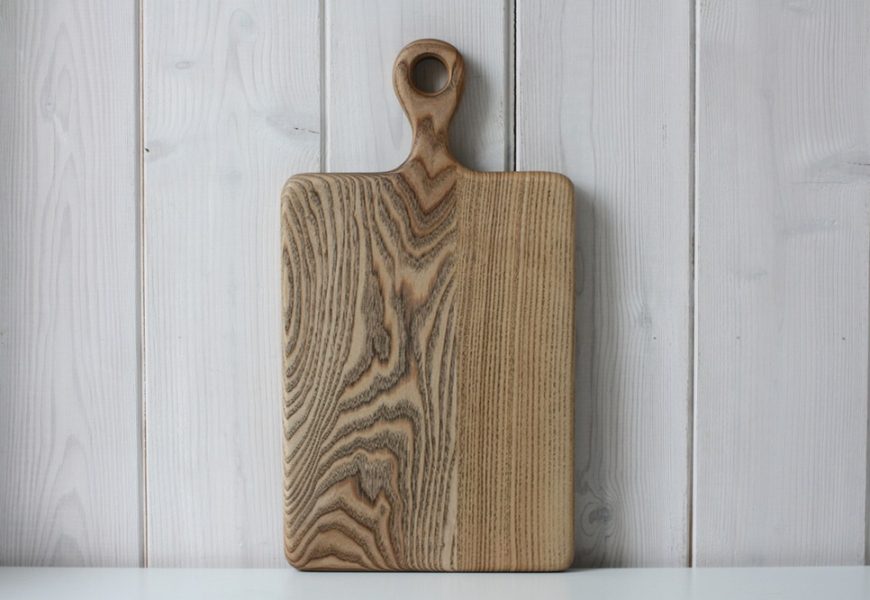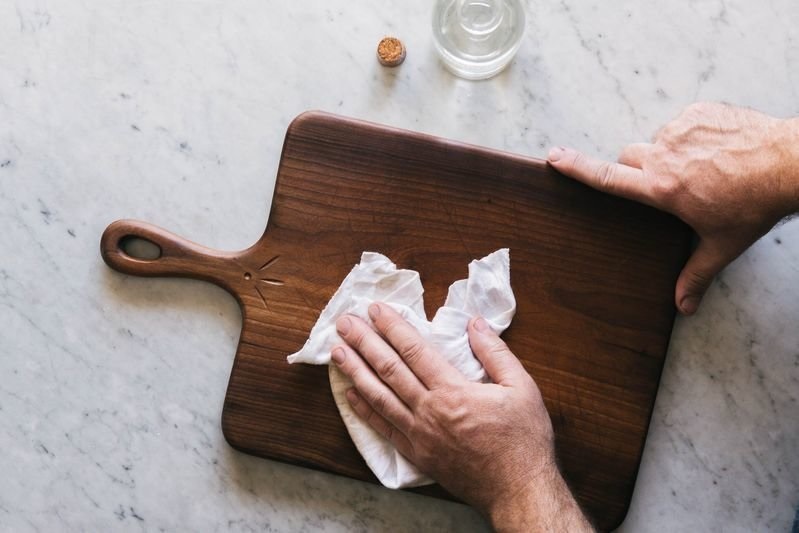Why Mold Grows On Wood Cutting Board And How To Remove It
Mold grows on wood cutting boards because wood is porous. This means it absorbs water, food particles, and bacteria, creating a perfect environment for mold to thrive. If the cutting board isn’t cleaned and dried properly after use, moisture stays in the wood, encouraging mold growth. Humid kitchen conditions can also worsen the problem.
To remove mold, start by washing the cutting board with hot water and dish soap. Use a stiff brush to scrub the surface and remove visible mold. Next, sanitize the board using a mixture of water and a small amount of vinegar or a specialized food-safe cleaner. Let it soak for a few minutes before rinsing thoroughly. Dry the board immediately with a clean towel and let it air dry completely before storing it.
Inspect Your Cutting Board For Mold
Inspecting your wood cutting board for mold is important for keeping it safe to use. Look for black, green, or white spots, which are common signs of mold. Pay special attention to any cracks or grooves, as mold can hide in these areas. Mold may also have a musty smell, even if it isn’t visible right away. If you’re unsure whether the spots on your cutting board are mold or stains, consider using a mold testing services Maine to confirm. Mold should be removed as soon as it’s found to prevent it from spreading further.
Inspecting your board also helps you notice any damage, like deep cuts or warping. Boards in poor condition are more likely to grow mold because they trap more moisture and food particles. By catching mold early, you can clean and maintain your cutting board more effectively.
Safety Tips Before Cleaning Moldy Boards
When cleaning a moldy cutting board, it’s important to take safety precautions. Mold can release spores into the air, which may irritate your skin, eyes, or lungs. Wear gloves to protect your hands and a mask to avoid breathing in mold spores.
Clean the board in a well-ventilated area, such as near an open window or outdoors if possible. Avoid scrubbing the board too vigorously at first, as this could spread mold spores. Use mild cleaning products that are safe for wood and avoid harsh chemicals that could damage the board. Always wash your hands thoroughly after handling the moldy cutting board and cleaning tools. Disinfect any brushes, sponges, or cloths used during the cleaning process to prevent spreading mold to other surfaces.
Prepare Necessary Tools And Cleaning Materials
Before you begin cleaning your moldy cutting board, gather all the necessary tools and materials. You’ll need a stiff brush or sponge to scrub the board, dish soap, and hot water for cleaning. To sanitize the board, you can use vinegar, hydrogen peroxide, or a food-safe disinfectant.
Other helpful items are: a pair of gloves to protect your hands, a towel to dry the board, and food-safe mineral oil for maintenance after cleaning. If the board has deep grooves, fine-grit sandpaper might be needed to smooth the surface. Preparing everything before you start makes cleaning faster and better. It ensures you can properly clean and disinfect the board without stopping to find tools or supplies midway through the task.
Scrub Mold Off The Cutting Board
Scrubbing is the first step to removing mold from a wooden cutting board. Start by rinsing the board with warm water to loosen the mold. Apply dish soap to the surface, then use a stiff brush or sponge to scrub away the visible mold. Focus on areas with deep grooves or cracks, as mold often hides there.
Rinse the board thoroughly with hot water to remove any remaining soap and mold. If the mold is stubborn, sprinkle baking soda on the board and scrub again, as baking soda helps lift tough stains. Be careful not to use too much force, as this could damage the wood. Once all the mold is scrubbed off, rinse the board again and move on to the next step of disinfecting. Proper scrubbing ensures the surface is clean and ready for sanitizing.
Disinfect The Board To Remove Bacteria
After scrubbing, disinfecting the cutting board is essential to kill bacteria and mold spores. A simple and safe method is to mix one part white vinegar with three parts water. Apply the solution to the board and let it sit for five minutes. Then, rinse thoroughly with warm water.
Hydrogen peroxide can also be used for disinfection. Pour a small amount over the board and allow it to sit for a few minutes before rinsing. Avoid using bleach, as it can damage the wood and leave harmful residues. Sanitizing the board after cleaning removes any lingering bacteria, making it safe to use for food preparation again. Regular disinfection keeps your cutting board hygienic and mold-free.
Dry The Cutting Board Properly
Drying your wood cutting board properly is one of the most important steps to prevent mold from coming back. After washing and disinfecting the board, use a clean towel to wipe away excess water. Then, place the board upright or on a rack to air dry completely. Avoid leaving the board flat on a surface, as this can trap moisture underneath. Never store a damp cutting board, as moisture in the wood creates an ideal environment for mold to grow.
For extra care, consider placing the board in a sunny spot to dry, as sunlight helps kill bacteria and mold. Ensuring your cutting board is completely dry before storing it is key to keeping it clean and mold-free.
Apply Food-Safe Oil To Protect Wood
Once your cutting board is clean and dry, applying food-safe oil helps protect the wood and prevent future mold growth. Use mineral oil or a cutting board conditioner specifically made for wood. Avoid using cooking oils, as they can go rancid and create new odors.
To apply, pour a small amount of oil onto the surface and rub it in using a soft cloth. Cover all areas, including the edges. Let the oil soak in for a few hours or overnight, then wipe off any excess. Oiling your cutting board regularly keeps it hydrated and prevents it from absorbing too much water, which can lead to mold. This simple step also extends the life of your board, keeping it smooth and in good condition.
When To Replace Your Cutting Board
Sometimes, a wood cutting board becomes too damaged to clean effectively. Deep cracks, warping, or excessive mold that doesn’t come off after cleaning are signs it’s time to replace the board. A damaged board is harder to sanitize and can harbor bacteria and mold.
If you have mold issues, consult mold remediation services Maine. They can tell you how to keep your kitchen mold-free. Replacing your cutting board ensures your food preparation remains safe and hygienic. Investing in a new board when needed is better than risking contamination from an old, damaged one.










